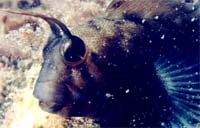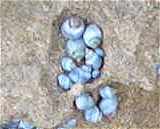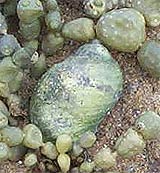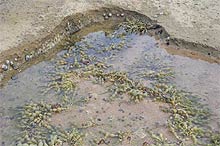|
Rocky Reefs
2. The Physical Environment
Ecology - Consumers
Many animals can be found on rocky shores and in rockpools. Because of the harsh conditions under which they live it is important that when observing these creatures they are left in the same locations that they were found. This is particularly important for animals that live in rockpools or underneath rocks. |

A Blenny - top order carnivore |
| |
|

periwinkles |
A wide range of small herbivorous snails, such as periwinkles, limpets, and warreners, are constantly grazing the rock surfaces and in many place their activity prevent large seaweeds from growing on the rocks.
Browsers and grazers include blue periwinkles (Littorina sp), limpets (Sellana tramoserica, Patelloida sp, Notoacmea sp, Sipohonaria diemenensis), Top shells (Austrocochlea constricta, A. odontis) Warrener (Turbo undulatus), Black Nerite (Nerita atramentosa), Conniwinks (Bembicium nanum), Chitons (Ischnochiton sp., Plaxiphora albida), Elephant snails (Scutus antipodes) , and Sea urchin (Heliocidaris erthrygramma). |
| |
|
|
In turn these are preyed upon by carnivorous snails, such as the dog whelk (Dicathais orbita), that have the ability to drill holes through the shells of their prey.
Other common carnivores on the rocky shore include the Waratah sea anenome (Actinia tenebrosa) and Green anenome (Cnidopus verarter) which capture food with their stinging tentacles. Blue ringed octopus (Hapalochlaena maculosa), Sand octopus (Octopus kaurna) and Maori octopus (O. maorum) are largely nocturnal predators also found on rock platforms. |

Dog whelk |
| |
|
| |
. |

mussels |
Many non-moving animals are also found on the rocky shore such as tube worms (Galeolaria caespitosa), mussels (Mytilus edulis, Austromytilus rostratus, Xenostrbus pulex) and barnacles. These all gain their food by filtering the seawater that passes them.
Other filter feeding animals include the unusual cunjevoi or sea squirts (Pyura stolonifera). |
| |
|
|
Scavengers such as crabs including the Red bait crab (Plaglusia chabrus) and Notched shore crabs (Paragrapsus sp.), shrimp, and some snails like the chequerboard snail (Cominella lineolata) scavenge the cracks between the rocks in search of dead or decaying material. Common seastar (Patiriella calcar ) and
Crimson seastars (P. brevispina) also scavenge for food on the rocks where they push there stomach out of their bodies to digest food.
During low tides Pacific gulls, oyster catchers and other birds feed upon snails and other animals. |

chequerboard snail |
| |
|

Rockpool |
The Subtidal Rocky Reefs support some of the most colourful and interesting marine communities. Subtidal reefs provide habitat for seaweeds, sponges, corals, fish, octopus, feather stars, and dozens of other creatures.
The sandstone and limestone reefs are particularly rich in life, as the soft rocks have eroded to form caves and ledges that give protection to the reef animals. Basalt reefs are often lacking in these large caves and ledges, but provide habitat for smaller animals or, like abalone, those with hard shells for protection. |
|
Next - Habitat Issues / Threats |
|